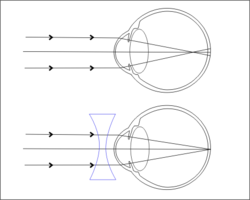Biophysics of eyesight disorders
== Description ==
Eyesight disorder is not the same as a eye disease(In disease case vision disorder could be consequences or pathological changes of a illness). It is caused by disproportionate structure of the eye, thought the eye anatomically healthy. And it can be corrected by glasses or contact lens.
For better understanding, eye is working as a camera, and light pass throw the cornea and lens focusing the light on retina. So problem occur when the light can't be correctly focused on the retina. Since the total refractive power of the eye is the sum of itscomponent refractive powers, we can correct Hyperopia and Myopia by placing extra lenses (eyeglasses or contacts) in front of the eye. Necessary refractive power for the lens can be calculated by lens formula. Refractive Power =1/f
Lens Formula[edit | edit source]
If the distances from the object to the lens and from the lens to the image are S1 and S2 respectively, for a lens of slight thickness, in air, the distances are related by the thin lens formula:
1/S1+1/S2=1/f
For example to calculate refractive power of a lens needed to nearsighted person. You need to find the vision correction in diopters that allows this person to see distant object clearly. By using lens equation 1/S1+1/S2=1/f , where S1-object distance, S2- image distance and f – focal length. For distant objects, the distance S1 from the object to the lens is infinity. Thus, the
corrected total refractive power should equal 1/S2. The correction, denoted by Δ1/f, is simply difference between the total refractive power for the corrected eyesight and the total refractive power of the nearsighted eye Δ1/f=1/f corrected – 1/f nearsighted
Common vision disorders:[edit | edit source]
Defects of the lens hyperopia[edit | edit source]
- hyperopia
- myopia
- astigmatism
Defects in the retinacolor blindness[edit | edit source]
- scotoma
- color blindness
Hypermetropia[edit | edit source]
Called error of refraction, in which light rays entering the eye and not focusing on the retina, but behind her. The reason is a small size of the eyeball, or week refractive power of the eye lens system. So for people who have hypermetropia is much harder to focus on a close object than on a far one. For eyeglasses are selected converging lenses(move focus forward to the retina).Focusing lens adds the extra convergence needed to bring the image into focus on the retina.
Myopia[edit | edit source]
Eye refractive error in which parallel light rays from distant objects focus in front of retina and person receive blurred image on retina. In opposite to
hyperopia, close objects are more clearly visible than distance objects. The main reason is increased in length eyeball. Diverging lens adds negative
refractive power (divergence) to bring objects into focus.
Astigmatism[edit | edit source]
Eye optical defect, when they light rays enter the eye and do not focus correctly( not focused on the same plane) on the retina as a result you receive blurred
image. Which is caused by wrong shape of the cornea or lens. Which can be corrected by using eyeglasses or alternatively, the cornea may be reshaped surgically with incisions or laser ablation to achieve the necessary changes in refractive power. This procedure is known as keratotomy.
Color blindness[edit | edit source]
It is a syndrome inability of people distinguish one or several colors. The reason are cones - color-sensitive receptors located in the central part of the retina, which perform their functions due to the special pigments. There are 3 types of these nerve cells and each of them responsible for 1 of 3 basic colors: red, blue and green. Accordingly, the light-sensitive pigments react to wave 552-557 nm, 426 nm and 530 nm.
Scotoma[edit | edit source]
Blind spot, areas where eyesight significantly weakened of absent . Caused by disease in the retina, optic nerve disease, glaucoma.
- Absolute scotoma - An area where vision is absent.
- Relative scotoma - An area where vision is significantly reduced
Assume the presence of scotomas can be distinguished by the Amsler test
Links[edit | edit source]
http://en.wikipedia.org/wiki/Lens_(optics)#Lensmaker.27s_equationCite error: Invalid <ref> tag; refs with no name must have content
http://www.patient.co.uk/doctor/refraction-and-refractive-errors
http://micro.magnet.fsu.edu/primer/lightandcolor/humanvisionintro.html





